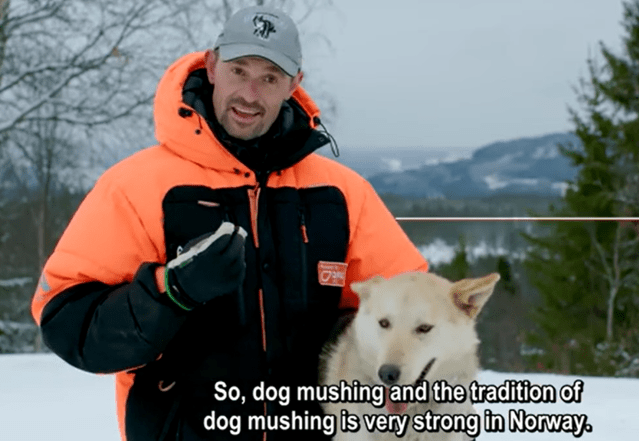
By craigmedred on • ( 5 Comments )

Norwegian Thomas Waerner of The QRILL Pet Mushing Team/Aker Biomarine
With snow falling and the weather warming along the Bering Sea Coast, the Iditarod Trail Sled Dog Race slogged past the COVID-19 worried village of Shaktoolik on Sunday night hours off the record pace for the event’s northern route with a Norwegian in the lead.
In an effort to protect against the spread of disease, residents of the community moved the checkpoint a couple miles out of town to a cabin near the Old Shaktoolik townsite where they turned out to welcome the first Iditarod musher.
In the race lead was 46-year-old, English-born, Norwegian raised Thomas Waerner, a former sprint dog driver in both Europe and Alaska, and the 2015 Iditarod rookie of the year. He is now running in what is only his second Iditarod.
An electrical contractor by trade married to a veterinarian, Waerner is backed by AkerBioMarine, a major Norwegian fishing company that mines the waters off Antarctica to supply krill-based food additives to Norway’s salmon farms.
Along with being rich in Omega-3 fat acids, the tiny, shrimp-like krill contain a chemical vital to giving the flesh of farmed salmon the healthy red color favored by consumers.
Bigger business
Ulsom, a Norwegian who now lives in Willow, was running ninth in the race Sunday night. Seavey, who lives just up the George Parks Highway from Ulsom in Talkeetna, was commentating on the race for Iditarod and the Qrill Pet Arctic World Series.
QPAWS, as it is being branded, is trying to blend the Iditarod, Minnesota’s John Beargrease Sled Dog Marathon, Norway’s Femund Race and Russia’s Volga Quest into something of a sled-dog version of the NASCAR Cup Series.
Aker Biomarine’s promotional material indicates it is trying to leverage Iditarod success into pet-food sales.
“QRILL Pet is Aker BioMarine’s own pet food brand, delivering highly nutritional solutions based on sustainable harvest of krill from the ocean. A unique and natural source of marine proteins, omega-3’s and more , with documented health and performing benefits for all types of dogs. If you want your dog to take advantage of this unique functional ingredient look for dog food brands with the ‘Powered by QRILL Pet’ logo on the package or product website,” the QPAWS website says.
With two Iditarod champions on the QRILL Team, the company would become a dominant Iditarod force by adding a third.
Alaskan chasing
When Waerner pulled into the relocated Shaktoolik checkpoint, his closest competition was Brent Sass from Eureka in Central Alaska. Sass famously flamed out in his last Iditarod in 2016.
Hoping to catch then race leader Dallas Seavey and his father Mitch, Sass cut his teams’ rest along the coast. It worked to move him within less than two hours of the lead at the penultimate checkpoint of White Mountain, where all the teams are required to take a mandatory, eight-hour rest.
When he got the dogs up to go after that long stop 80 miles from the finish line, however, the team balked. By the time they’d recovered to the point where they were ready to undertake the final leg of the race, Sass had 19 teams instead of two in front of him.
The younger of the Seavey’s, meanwhile, went on to set a record time of 8 days, 11 hours and 20 minutes for the Iditarod’s northern route that year.
Waerner was a good 10 hours off that pace when he arrived in Shaktoolik, but he appeared to have built a comfortable lead. And back in Unalakleet, Aaron Burmeister from Nenana – a five-time, top-10 Iditarod finisher running his 19th race this year – might have had the most telling observation on the last leg of the race along the coast.
Most of the Alaska mushers chasing Waerner have spent the winter training their dogs in temperatures of 20- to 40-degrees below zero, he said, which gives the Norwegian musher who has trained in much warmer weather a significant advantage in the warm weather now settling over the coast.
Dogs environmentally acclimate by thermoregulating their bodies to deal with the world around them. When they have set their internal thermostats so as to stay warm at 40 degrees below zero, it can take them days to adjust to temperatures 60 degrees warmer or more.
The temperature along the coast on Sunday night was creeping above 30, and the dogs were pushing on through new snow, which requires somewhat more energy than a hardpacked trail.
The harder dogs work the more body heat they generate. They are just like people in that regard. And as a more than 20 year old sled dog website notes, “when muscles get too warm, they function less efficiently.”
As a result, runners – be they canine, human or equine – then slow down.
With Waerner now in the Iditarod lead, and with weather conditions shifting in his favor along the coast, the race would now appear his to lose.